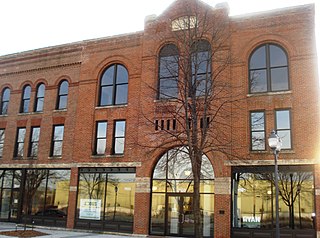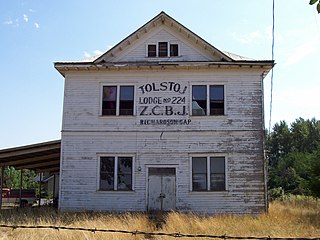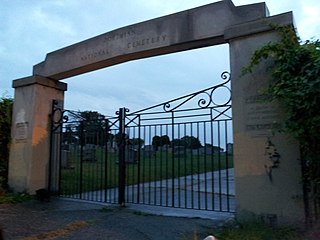
The C.S.P.S. Hall, also known as Czech Hall or as CSPS Sokol Hall, is the home of the Czech-Slovak Protective Society Hall — a recreation center and meeting house used for social events, including Sokol events; important to the cultural preservation of Czech and Slovak immigrants in Saint Paul, Minnesota. It is listed on the National Register of Historic Places.
Zapadni Cesko-Bratrska Jednota or Západní Česko-Bratrská Jednota, also known as ZCBJ or ZČBJ, was a Czech-language newspaper in the United States. It was founded and published by Jan Rosický (1845–1910).

The C.S.P.S. Hall in Cedar Rapids, Iowa, USA was built during 1890-91 and expanded twice in the next two decades. It was a social and cultural center of the local Czech-Slovak Protective Society (C.S.P.S.). The building was individually listed on the National Register of Historic Places in 1978. In 2002 it was included as a contributing property in the Bohemian Commercial Historic District.

The Czecho Slovakian Association Hall, also known as Preucil School of Music, is a building in Iowa City, Iowa that was built in 1900, as a community center and meeting place for the Czechoslovakian Protective Society (C.S.P.S.), which later became the Czecho Slovakian Association. The C.S.P.S., like other fraternal organizations, began by offering a kind of insurance. The local chapter was organized in Iowa City in 1882. It served the Czech community that was concentrated in the north and northeast areas of the city. Like other C.S.P.S. halls, it hosted social, cultural, and educational activities, and this one also hosted gymnastics.

The ZCBJ Hall, also known as Community Hall, is a building in Haugen, Wisconsin, United States, that was built in 1910. It was listed on the National Register of Historic Places in 1985. It historically served as a meeting hall for the Czech community.

The Z.C.B.J. Tolstoj Lodge No. 224, also known as Bohemian Hall or Tolstoj Sokol Lodge, is a historic building in rural Linn County southeast of Scio, Oregon, United States, that was built in 1911. It was listed on the National Register of Historic Places on September 14, 1995. It historically served as a meeting hall for the Czech community. The lodge organized a Czech school, in addition to hosting concerts, dances, Sokol events and Fourth of July celebrations.

The Rad Saline Center cis. 389 Z.C.B.J., also known as Saline Center Lodge Hall, is an historic building in rural Nebraska located about 9 miles north of Western, Nebraska that was built in 1939. It was listed on the National Register of Historic Places on January 4, 1996. It historically served as a meeting hall for the Czech community.

The Rad Plzen cis. 9 ZCBJ (SD10-6) is a building located in Morse Bluff, Nebraska that was built in 1911. It was listed on the National Register of Historic Places on March 20, 1986. The building historically served as a meeting hall for the Czech community. It was the meeting hall for the ZCBJ Lodge Plzen, a branch of the Zapadni Ceska Bratrska Jednota. The ZCBJ Lodge Plzen was originally organized on June 6, 1880 as a branch of the Czech-Slovak Protective Society, but was incorporated into ZCBJ in 1897.

The ZCBJ Lodge No. 46, also known as Bohemian Hall, is an historic building located in Prague, Oklahoma that was built in 1917. It was listed on the National Register of Historic Places on March 8, 1984. The building historically served as a meeting hall for the Czech community, hosting a Zapadni Ceska Bratrska Jednota lodge that was the oldest Czech fraternal order in Oklahoma. The lodge was originally organized in 1891 as a branch of the Czech-Slovak Protective Society, but was incorporated into Zapadni Ceska Bratrska Jednota in 1897.

The Z. C. B. J. Hall, also known as Bohemian Hall or Zapadni Cesko Bratrske Jednota Hall, is an historic building located near Arthur, Wisconsin that was built in 1907. It was listed on the National Register of Historic Places on June 25, 1992. It historically served as a meeting hall for the Czech community.

Cesko-narodni sin-Milligan Auditorium, also known as Milligan Auditorium, is a historic building in Milligan, Nebraska, USA, that was built in 1929. It was listed on the National Register of Historic Places on February 29, 1996. The building is a meeting hall for the Czech community. It historically hosted dances, Sokol events, films and Czech theater.

Z.C.B.J. Opera House is an historic building located in Clarkson, Nebraska, United States, that was built in 1913 by the Zapadni Ceska Bratrska Jednota, or Western Bohemian Fraternal Association. It was listed on the National Register of Historic Places on September 28, 1988. The building serves as a meeting hall for the Czech community. It has hosted operas, dances, lectures, films and Czech heritage events.

The Rad Sladkovsky lodge, also known as Pishelville Hall, is a building located near Verdigre, Nebraska that was built in 1884. It was listed on the National Register of Historic Places on June 29, 1982. The building historically served as a meeting hall for the Czech community, hosting a Zapadni Ceska Bratrska Jednota (ZCBJ) lodge that was the oldest Czech fraternal order in Nebraska. The lodge was originally organized as a branch of the Czech-Slovak Protective Society, but was incorporated into the ZCBJ in 1897.

Bohemian National Cemetery, also known as Oak Hill Cemetery, is a cemetery located at 1300 Horners Lane, Armistead Gardens in East Baltimore, Maryland.

The Western Fraternal Life Association, previously known as Zapadni Ceska Bratrska Jednota is a fraternal benefit society and financial services organization in the United States. The association has its roots in the Czechoslovak immigrant community of the 19th century. It was once the second largest Czech-American freethought fraternity in the United States.
The Grand Lodge Č.S.P.S. of Baltimore is the Baltimore, Maryland chapter of the Czech-Slovak Protective Society. The C.S.P.S. is a benevolent society that was founded to help Czech and Slovak immigrants integrate into American society. The chapter was founded in 1880 by Vaclav Joseph Shimek, who was also the publisher of the Telegraf, the owner of Bohemian Hall, and a six-time president of Sokol Baltimore.

The Western Bohemian Fraternal Union Hall is a historic clubhouse in Meadowlands Township, Minnesota, United States. It was built in 1925 as a meeting hall for a lodge of the Western Bohemian Fraternal Union, a society of Czech Americans. The hall also served as a host for Sokol gymnastics events. The hall was listed on the National Register of Historic Places in 1986 for its local significance in the themes of European ethnic heritage and social history. It was nominated for being a long-serving rural venue for the preservation of Czech American culture and heritage.

Lodge Zare Zapadu#44, known locally as Yellow Brick Hall and also known as Bohemian Brick Hall and Z.G.B.J. Council Hall #44, is a historic clubhouse of the Zapadni Ceska Bratrska Jednota serving the Czech-American community in rural Freeborn County, Minnesota, United States.
Lodge Boleslav Jablonsky No. 219 is the meeting hall of a Czech American fraternal society in Poplar Grove Township, Minnesota, United States. The hall was built in 1916 and remains in use as of 2016. It was listed on the National Register of Historic Places in 2002 for having local significance in the themes of European ethnic heritage and social history. It was nominated for being a representative of ethnic history in the last part of Minnesota to be settled by Euro-Americans.
















